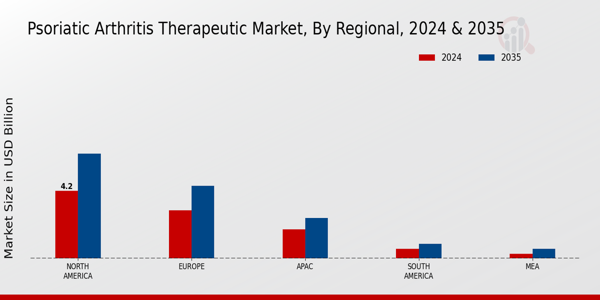Advancements in Biologic Therapies
Advancements in biologic therapies represent a crucial driver for the Psoriatic Arthritis Therapeutic Market. Biologics have transformed the treatment paradigm for psoriatic arthritis, offering targeted therapies that address the underlying inflammatory processes. The introduction of new biologic agents has expanded treatment options, providing patients with more effective and personalized care. Market data indicates that the biologics segment is expected to witness substantial growth, with a projected compound annual growth rate (CAGR) of over 10% in the coming years. This growth is fueled by ongoing research and development efforts aimed at discovering novel biologic agents that can improve patient outcomes. As healthcare providers increasingly adopt these therapies, the market for psoriatic arthritis treatments is likely to experience significant expansion, driven by the demand for innovative and effective solutions.
Rising Prevalence of Psoriatic Arthritis
The increasing prevalence of psoriatic arthritis is a primary driver for the Psoriatic Arthritis Therapeutic Market. Recent estimates suggest that approximately 0.5 to 1 percent of the population is affected by this condition, leading to a growing demand for effective therapeutic options. As awareness of the disease rises, more individuals are seeking diagnosis and treatment, which in turn propels market growth. The need for innovative therapies that can address the diverse symptoms and complications associated with psoriatic arthritis is becoming increasingly apparent. This trend indicates a robust market potential for pharmaceutical companies and healthcare providers, as they strive to meet the needs of an expanding patient population. Consequently, the rising prevalence of psoriatic arthritis is likely to continue influencing the therapeutic landscape significantly.
Integration of Digital Health Technologies
The integration of digital health technologies is emerging as a significant driver for the Psoriatic Arthritis Therapeutic Market. Telemedicine, mobile health applications, and wearable devices are transforming how patients manage their condition and interact with healthcare providers. These technologies facilitate remote monitoring, enabling patients to track their symptoms and treatment responses more effectively. Market data suggests that the digital health market is expected to grow substantially, with a projected CAGR of over 20% in the coming years. This growth is likely to enhance patient engagement and adherence to treatment regimens, ultimately improving health outcomes. As digital health solutions become more prevalent, they are expected to play a crucial role in shaping the future of psoriatic arthritis management, thereby influencing the therapeutic market.
Growing Awareness and Education Initiatives
Growing awareness and education initiatives surrounding psoriatic arthritis are pivotal drivers for the Psoriatic Arthritis Therapeutic Market. Increased efforts by healthcare organizations and advocacy groups to educate both patients and healthcare providers about the disease are leading to earlier diagnosis and treatment. This heightened awareness is crucial, as it encourages individuals experiencing symptoms to seek medical attention, thereby increasing the patient population in need of therapeutic interventions. Furthermore, educational campaigns are fostering a better understanding of the disease's impact on overall health, which may lead to more comprehensive treatment approaches. As awareness continues to grow, the demand for effective therapies is likely to rise, further propelling the market for psoriatic arthritis treatments.
Increased Investment in Research and Development
Increased investment in research and development (R&D) is a significant driver for the Psoriatic Arthritis Therapeutic Market. Pharmaceutical companies are allocating substantial resources to develop new therapies that can effectively manage psoriatic arthritis. This focus on R&D is essential, as it leads to the discovery of novel treatment options that can address unmet medical needs. Recent data indicates that global spending on R&D in the pharmaceutical sector has reached unprecedented levels, with billions of dollars being invested annually. This trend is likely to result in the introduction of innovative therapies that can enhance patient care and improve quality of life. As the pipeline for new treatments expands, the Psoriatic Arthritis Therapeutic Market is poised for growth, driven by the continuous evolution of therapeutic options.


















Leave a Comment